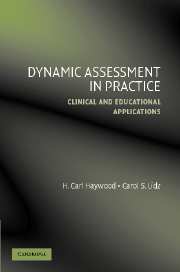Book contents
- Frontmatter
- Contents
- Preface
- Foreword, by Kenneth A. Dodge
- Foreword, by Thomas Oakland
- PART ONE THEORY AND PRINCIPLES
- PART TWO APPLICATIONS
- 4 Dynamic Assessment in Clinical Settings
- 5 Dynamic Assessment in Educational Settings
- 6 Applying Dynamic Assessment with Young Children
- 7 Applying Dynamic Assessment with School-Age Children
- 8 Applying Dynamic Assessment with Adults and Seniors
- 9 Writing Reports and Developing IEPs and Service Plans with Dynamic Assessment
- 10 Unresolved Issues, Conclusions, and Recommendations
- APPENDIX A TESTS REFERRED TO IN THE TEXT THAT DO NOT BELONG TO THE AUTHORS
- APPENDIX B SOURCES OF DYNAMIC ASSESSMENT MATERIALS
- References
- Author Index
- Subject Index
- Tests and Testing Materials Index
6 - Applying Dynamic Assessment with Young Children
Published online by Cambridge University Press: 04 December 2009
- Frontmatter
- Contents
- Preface
- Foreword, by Kenneth A. Dodge
- Foreword, by Thomas Oakland
- PART ONE THEORY AND PRINCIPLES
- PART TWO APPLICATIONS
- 4 Dynamic Assessment in Clinical Settings
- 5 Dynamic Assessment in Educational Settings
- 6 Applying Dynamic Assessment with Young Children
- 7 Applying Dynamic Assessment with School-Age Children
- 8 Applying Dynamic Assessment with Adults and Seniors
- 9 Writing Reports and Developing IEPs and Service Plans with Dynamic Assessment
- 10 Unresolved Issues, Conclusions, and Recommendations
- APPENDIX A TESTS REFERRED TO IN THE TEXT THAT DO NOT BELONG TO THE AUTHORS
- APPENDIX B SOURCES OF DYNAMIC ASSESSMENT MATERIALS
- References
- Author Index
- Subject Index
- Tests and Testing Materials Index
Summary
This chapter focuses on procedures for applying the dynamic assessment model to children during early childhood, which is usually considered to range from 3 through 8 years; however, our focus here is preschool, or age 3 through 5, and we delegate ages above 5 to the school-age chapter. In this chapter, we present Lidz and Jepsen's Application of Cognitive Functions Scale (ACFS) in its entirety.
OVERVIEW OF DYNAMIC ASSESSMENT PROCEDURES FOR USE WITH YOUNG CHILDREN
Carrying out assessments with young children can be challenging under any conditions, and specialized approaches, techniques, and training are warranted for this population (Lidz, 2003). Carrying out dynamic assessment with young children is not only challenging, but, in the minds of some professionals, even questionable, because the metacognitive functions typically targeted by DA are not yet well developed. Metacognitive or executive functions are nevertheless emerging even at ages as young as 3, and it can be very worthwhile to explore how well these functions can be facilitated within the context of dynamic assessment.
Important contributions to development and application of dynamic assessment procedures with young children have been made by Burns (1980, 1985), Guthke and Loffler (1983), Haeussermann (1958), Hessels (2000), Kahn (2000), Karpov (1982), Peña (2000), Resing (2000), Schlatter and Büchel (2000), Tzuriel, (2001), and Tzuriel and Klein (1985). Most of these approaches, with the exception of Kahn's, are appropriate for use with children in the early primary grades, and the focus tends to be on gaining access to intellective functioning.
- Type
- Chapter
- Information
- Dynamic Assessment in PracticeClinical and Educational Applications, pp. 91 - 175Publisher: Cambridge University PressPrint publication year: 2006



